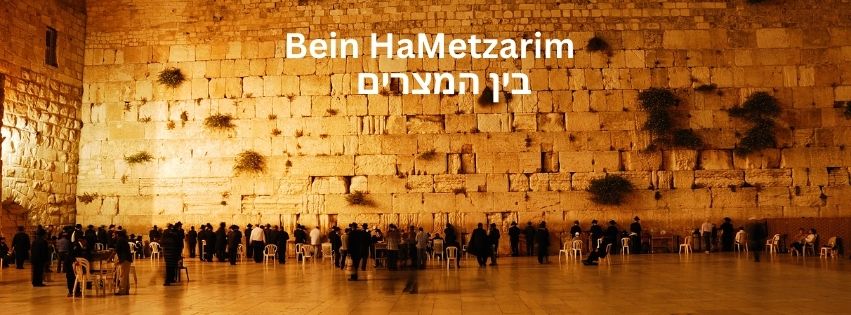Bein HaMetzarim, also known as the “Three Weeks,” in Hebrew: בין המצרים , is a significant period of mourning in the Jewish calendar, commemorating the destruction of the First and Second Temples in Jerusalem. This period spans from the 17th of Tammuz to the 9th of Av, encompassing various customs and observances that reflect the somber nature of these days.

What is Bein HaMetzarim?
The term Bein HaMetzarim translates to “between the straits” or “within the borders,” derived from a verse in the Book of Lamentations: “All her pursuers overtook her between the straits” (Lamentations 1:3). This period is marked by historical tragedies for the Jewish people, leading to a time of reflection and mourning.
Dates and Historical Significance
The Three Weeks begin on the 17th of Tammuz and end on the 9th of Av:
- 17th of Tammuz: This day marks several calamities, including Moses breaking the tablets of the Ten Commandments, the cessation of daily sacrifices in the First Temple, and the breaching of Jerusalem’s walls by the Romans in 70 CE.
- 9th of Av (Tisha B’Av): This day commemorates the destruction of both the First and Second Temples, among other tragedies, such as the expulsion of Jews from Spain in 1492.
Customs and Observances- bein hametzarim rules
During Bein HaMetzarim, Jews observe various customs that increase in intensity as Tisha B’Av approaches:

General Customs (17th of Tammuz to the end of Tammuz)
- No Weddings or Celebrations: Weddings and other joyous events are avoided to maintain a mood of mourning.
- Avoiding Haircuts and Shaving: Many refrain from cutting their hair or shaving during this period.
The Nine Days (Rosh Chodesh Av to Tisha B’Av)
- Abstaining from Meat and Wine: Except on Shabbat, meat and wine, which are traditionally associated with joy, are avoided.
- Limited Bathing and Laundry: Bathing is restricted to essential hygiene, and laundry is typically not done.
- No New Clothes: Purchasing or wearing new clothes is avoided to minimize joy.
Tisha B’Av
- Fasting: A full fast is observed from sunset to the following nightfall.
- Mourning Practices: Activities include sitting on low stools, reading the Book of Lamentations, and reciting kinnot (elegies).
Reflection and Hope
Despite the mourning, there is an element of hope embedded in the observance of Bein HaMetzarim. The haftarot (prophetic readings) during this period contain admonitions but also promises of eventual redemption. This duality emphasizes the belief in future restoration and the rebuilding of the Temple.
Bein HaMetzarim in a Macro View
Bein HaMetzarim is a profound period of mourning and reflection in the Jewish calendar. It serves as a time to remember past tragedies, observe customs that reflect the a sad mood, and maintain hope for future redemption. Through these practices, the Jewish community honors its history while looking forward to a brighter future.
